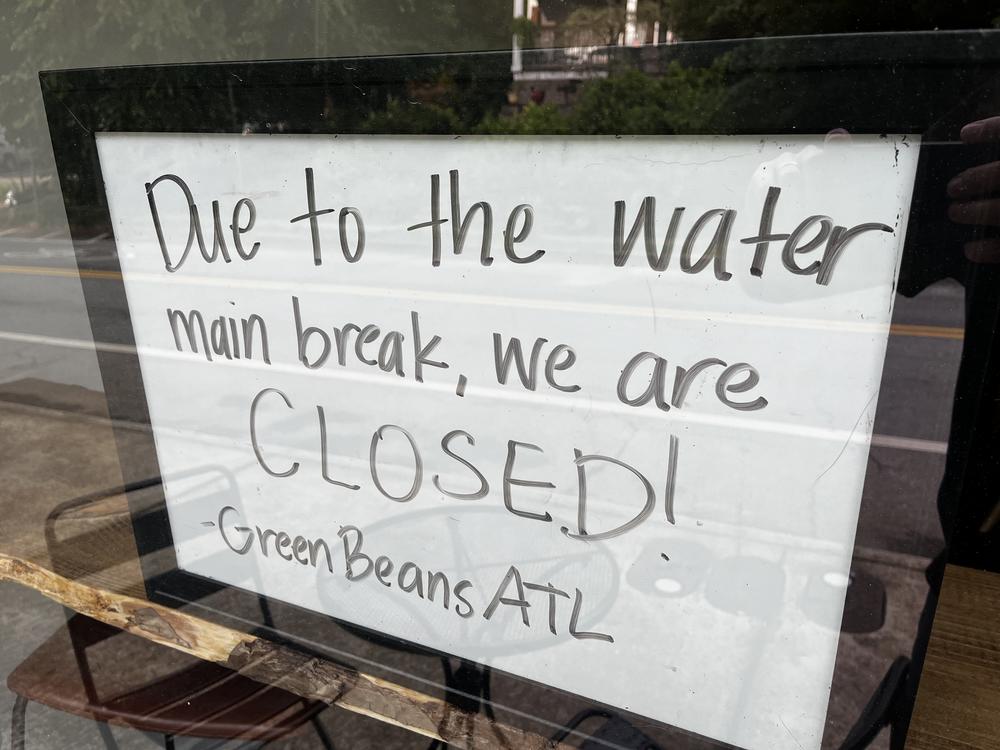
Caption
Green Beans ATL coffee shop on United Avenue in Atlanta closed on Sunday, June 2nd as the city of Atlanta worked to repair several water main breaks.
Credit: Peter Biello
LISTEN: Since Friday, some residents have gone without water and businesses and government offices have temporarily closed. For a broader view of this infrastructure failure, GPB's Peter Biello turns to Dr. Iris Tien with Georgia Tech.

Green Beans ATL coffee shop on United Avenue in Atlanta closed on Sunday, June 2nd as the city of Atlanta worked to repair several water main breaks.
As of Monday afternoon, a state of emergency remained in effect for a large portion of Atlanta, as the city continues to repair broken water mains. Since Friday, some residents have gone without water and businesses and government offices have temporarily closed. But for a broader view of this infrastructure failure, we turn to Dr. Iris Tien. She's an associate professor in the School of Civil and Environmental Engineering at Georgia Tech. She spoke with GPB's Peter Biello.
Peter Biello: It's not uncommon for cities to experience a water main break, but how could it be that several major and minor water main breaks flooded city streets at the same time?
Iris Tien: So that's one of the things that we look at in looking at these infrastructure systems that are all connected. And so we have this thing called cascading effects and cascading failures and outages, where one failure is actually the trigger effect for follow-on cascading failures through the system. And so in this case, with the water main break, once one of the mains breaks the flow, is just rerouted through other parts of the system, which can stress other parts of the network. And so it's actually not necessarily a coincidence that they would fail together, but it's actually that one of these breaks triggers these other main breaks like a domino effect.
Peter Biello: I see. And can you talk a little bit about the age of Atlanta's water infrastructure and how the growth of the city, maybe, has impacted infrastructure like water mains?
Iris Tien: Certainly. So this is one of the things that we see across the U.S. In Atlanta, as well as in other cities across the U.S. is this whole issue of aging infrastructure. So we have these systems that have been designed for maybe 50 years, maybe up to 100-year service lives. But we're really near that mark and a lot of Atlanta system is — is past that 50-year mark. And so we see these systems that are aging. And so without enough resources to replace things before they potentially break, we see these failures across the system where we have these aging components, which then can cause other components to fall as well.
Peter Biello: What possible role does a changing climate play in what we're experiencing now?
Iris Tien: That's an interesting question. There's a lot of work and research in terms of how changing demands can put additional stresses on the system. And so certainly as systems get used more and more, the stresses on the system also increase. And that could potentially shorten their lifetime or increase the demands on the structural components, certainly. And there are also questions about increased flooding and saturation of the soils might also potentially lead to the shifting soils where these buried infrastructure assets are located. And that could also potentially affect the performance of these pipelines.
Peter Biello: What can be done in a city like Atlanta that's old, but that's experienced a lot of growth, that could address this problem, not in a Band-Aid solution kind of way, but in a way that comprehensively addresses the issue?
Iris Tien: That's one of the tricky things with infrastructure, is that they are very long-lived assets, and they're continually being built on and expanded. And so a system like the city of Atlanta has this original backbone, but then with development, new assets are added on. And so we have this conglomeration of new assets, old assets. We have different levels of information about them. And so there's varying potential ways that we could address some of these issues. One of the first is even just knowing where everything is and how everything is connected. And so we have that — that data question first. And then there's also ways that we could implement new technologies, things like sensor monitoring to track potential leaks that might be a precursor to a larger break. There are different potential redundancies we could build into the system at the more local scale, but also at the utility level. And so there's different things that, from a research point of view we're looking at as well from different household to local-scale solutions, to potential utility-scale solutions, to build in more redundancies and backups to these systems so that when a potential outage or disruption happens, that the system is able to recover and find new ways to to be able to almost automatically recover and provide services to the populations that need them.